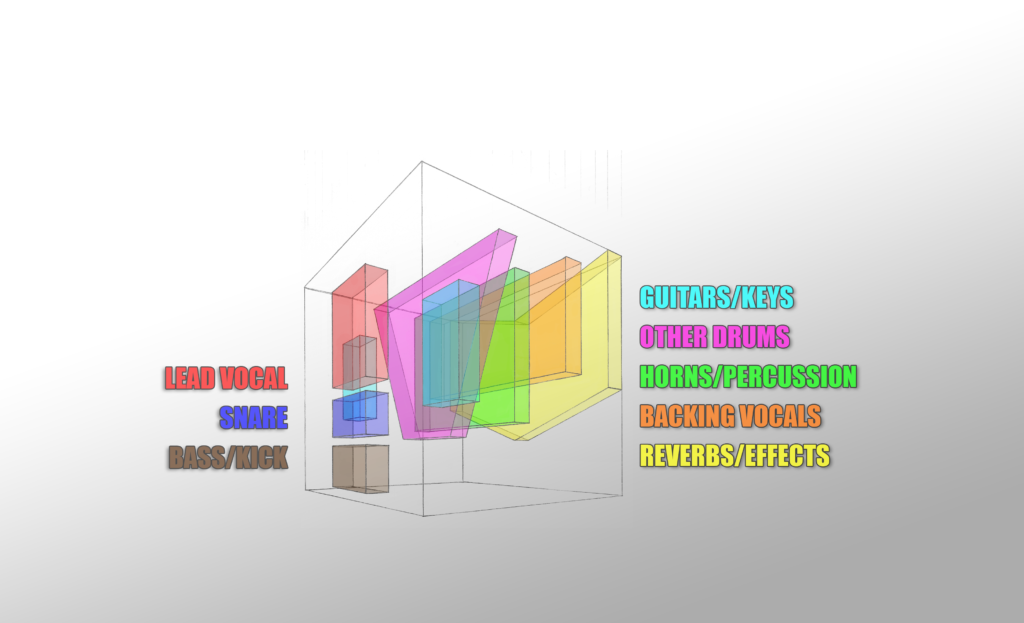It’s 11:45am, forty-five minutes after Call Time. Fortunately, you’re the bassist, so it’s safe to assume you’ll take way less time to set up, and your lateness probably won’t matter. You ring the buzzer by the front door labelled Matrix Studio and a voice answers “Hey, come on up!”
The door clicks unlocked and you open it, grabbing your bass case and starting up the stairs. You briefly lament for the guitar player having to carry his 50kg Marshall Stack up here, before smiling when you remember that it isn’t your problem. You walk down the hall to the studio, finding Phill sitting in the control room, in front of a eye-watering array of speakers, monitors, knobs, and rack gear. You are surprised to learn that you’re the first to arrive.
For the next half-hour the complex is buzzing as the rest of the band arrive, they say g’day to Phill, and meet the new tech Robbie, then follow your lead in setting up their gear in the live room. The drummer fiddles with the tuning pegs and the seat height, coffees are ordered, and everybody avoids eye-contact when the guitarist asks for a hand with his amp.
Eventually the set-up is complete and you all congregate in the control room to form a plan of attack. Last time you were here the band all played together, just like at band practice, with numerous baffles and bits of foam trying their hardest to isolate each of the microphones. You all preferred it like that; it felt natural and really captured the ‘energy’ of the band. This time Phill suggests that we should aim for a more precise sound by laying down a guide track on guitar, bass, and vocals first, then have the drummer play to that guide to start the recording proper. Once the drums are right, each musician would then take it in turn to overdub their part as perfectly as possible. You’re all a little reluctant to switch to this method, but trust Phill’s experience, so decide to give it a go.
In the live room you tune up your bass, put your headphones on, and get comfortable. The guitarist is across from you, and the singer is in an isolation booth to your left. You hear “alright here we go,” in your cans and a metronome begins tapping away. The singer counts in and you start playing; it’s a little weird playing without drums, but you’ve practiced this song a lot, and having the singer turned up loud stops you from losing track of the structure. After a couple of takes everybody is happy with the guide, and you move on to the recording proper.
The drummer goes in first, laying down the foundation for the whole song. You listen from the control room, watching the lights on the pre-amps and compressors dance, working together to produce a crisp and powerful drum sound. “He’s a touch ahead of the beat” you hear Robbie say. “Nothing a bit of editing can’t fix” Phill replies. After only two takes the drummer re- joins the control room, requesting one section be slotted from the first take, and the rest of the song from the second.
Now you realise that it’s your turn to record. You move back to your position in the live-room, this time more aware of the whole band and two techs staring at you through the glass. There’s nowhere to hide in here, the only option is for you to play, and play well. You give them the thumbs-up and start playing through a take. You feel like you’re at the end of the song almost as soon as you start, and you cringe slightly when you hear “great, let’s do another one shall we?” Another take turns into three more, but you just don’t seem to be satisfying the perfection-hungry monsters behind the glass. You’re told to come through and have a listen to the last take, at which point Phill begins to gently explain all the little things wrong with your playing. It’s tough to hear. Then he asks if there’s a reason why you’re playing with a pick? You don’t usually, but for this song the singer requested it to get ‘that sound.’ “Well why don’t you try a take with your fingers?”
You walk back in to the live room, sit down, tune up, and fly into a take. This time all the notes land where they should; its easier to move from that arpeggio to the sixteenths with three fingers available instead of one pick. The tone is better too, smoother and more consistent where the pick had been too abrasive. You finish the take feeling great and look up… “Yup that’s the one.” That’s it, job done. You come back through to the control room and take a seat on the couches.
Now you get to spend the rest of the afternoon critiquing everybody ELSE’s playing! Everybody works hard; the guitarist ends up layering four different guitar sounds and ripping a wicked solo. The singer is the last to record, but somehow finds the energy to lay down near-perfect vocals, and even nails the doubles over himself in the choruses. It’s 8pm when he finishes the last line. You all sit and listen as Phill balances a quick mix, proud of the work everyone has done. It’s easy to hear that this recording method has resulted in a much tighter sound, even if it was more labour intensive. Somebody turns to you and says “man, that bass playing is awesome!”
It’s time to pack down and head home. You thank the engineers for their time, say goodbye to the band, and pretend not to hear the guitarist when he asks for a hand down the stairs.



